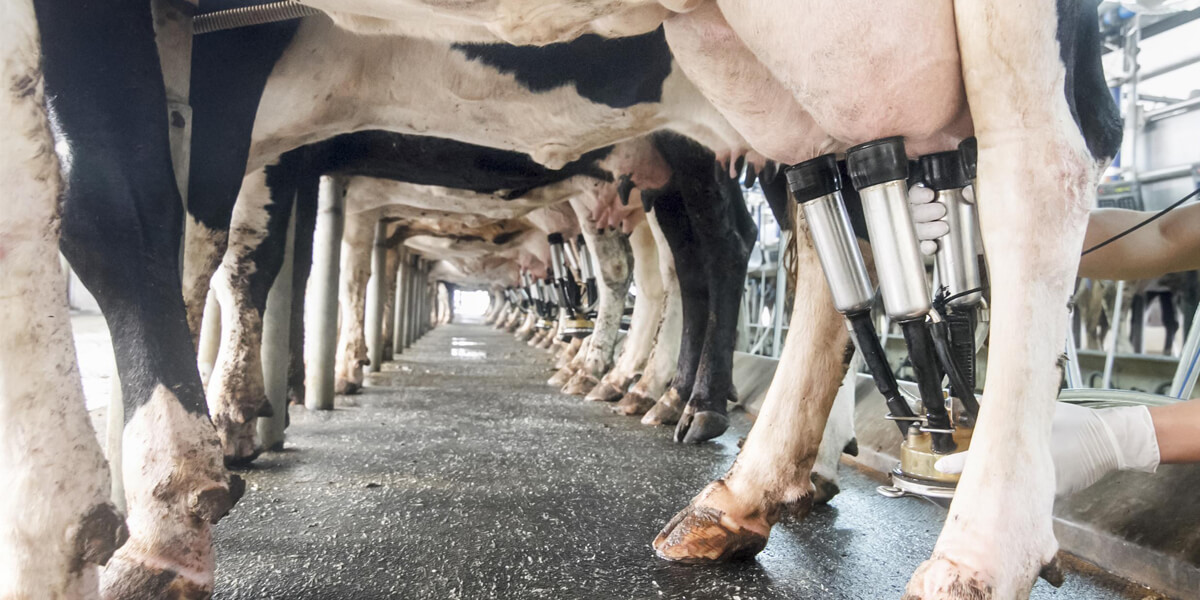Mastitis in dairy cows and high somatic cell count go hand in hand. If a cow becomes infected with mastitis, the inflammation causes an increase in somatic cell count, which ultimately reduces the quality of milk.
A cow is particularly susceptible to infections like mastitis during the transition period. During transition, a cow has a lot going on. The cow is going to give birth and shortly after, milk production will ramp up. This causes the cow to enter into a negative energy balance (i.e., immune-compromised), leaving less nutrients available for the immune system.
A cow is also susceptible to mastitis during dry-off. After dry-off, a cow is not being milked. Therefore, infectious bacteria are not being flushed from the mammary gland on a regular basis. Additionally, shortly after dry-off, cows may be moved away from the herd and observed less often. Furthermore, dry cow pens are usually cleaned less often, causing those cows to be more susceptible to infection. If a cow gets mastitis during the dry period, there is a good chance she will calve and start lactation with an elevated somatic cell count.
Improving milk quality in transition cows starts with improving mammary health and preventing the spread of infectious bacteria. With proper management and nutrition strategies, your dairy cows can produce high-quality milk when they come into lactation.
Tips for Improving Milk Quality in Transition Cows
- Maintain good foot, leg and tail hygiene
The same hygiene best practices that are employed to control digital dermatitis also apply to improving milk quality in transition. Keeping feet, legs and tails clean can help keep them free of infectious bacteria that cause mastitis in dairy cows and high somatic cell counts. We also need to ensure that free stalls are kept as clean as possible. - Eliminate employee-caused problems
Focus on things like making sure you’re not using the same towel to prep multiple cows and that you’re using disposable gloves and changing them regularly. This will help reduce the spread of mastitis. - Practice proper milking procedure
The milking process should include forestripping, which means to remove some milk before we actually put the unit on and start collecting the milk. This allows us to visually check for mastitis in the expressed milk. Also, the milk, if the cow has mastitis, that comes from each teat first is the most concentrated with bacteria, so we are able to keep this milk out of the bulk tank. It’s important to make sure cows have enough stimulation time prior to attaching the milking unit. If stimulation time is low, it takes longer to milk. This leads to an increase in contact time with the machines and increases the risk for bacteria to pass from the cow to the machine and vice versa. - Make sure your equipment is working properly
If you have old, worn-out equipment or faulty milking machines that aren’t cleaning themselves appropriately, this will spread bacteria from animal to animal and increase the incidence of mastitis. For example, if the vacuum is not working properly, it may leave the teat open for too long during milking. This creates an opportunity for bacteria to invade the mammary gland. - Incorporate dry-off management strategies
Since a high risk for mastitis in dairy cows occurs at dry-off, it is important to prepare cows for the dry period. Working with farm consultants and veterinarians to incorporate dry-cow treatments and/or teat sealants at the time of dry-off can significantly reduce the ability of bacteria to penetrate the teat end, thus lowering the risk of mastitis occurring.
Nutrition Strategies for Improving Milk Quality in Transition Cows
Performance trace minerals, particularly zinc, improve immune function to reduce the incidence of mastitis in dairy cows and, therefore, reduce somatic cell count. Supplementing your dairy nutrition program with zinc from Zinpro Performance Minerals® can improve the production of keratin within the teat end. Zinc helps keep pathogens out of the mammary gland and can produce an extra milligram of teat keratin over the course of a day.
For heifers, we recommend supplementing their diets with Zinpro® Availa® Plus as early as possible. It is usually incorporated as part of the digital dermatitis formula, but the high zinc content will also help in improving epithelial health and teat keratin production. The DD formula is meant to be fed specifically to non-lactating heifers and has been shown to reduce somatic cell counts in early lactation for first-lactation cows when they consumed it as heifers.
For cows, we recommend including Zinpro® Availa® Dairy in their diets. With 40 ppm of zinc, it will have a big impact on improving epithelial health and keratin production. For best results, start supplementation about four weeks before calving.
To learn more about improving dairy cow nutrition with performance trace minerals, visit us online. To ask about including Zinpro Availa-Plus or Zinpro Availa-Dairy in your dairy cow nutrition plan, contact a Zinpro representative today.

